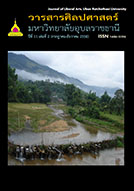แนวทางการพัฒนาการท่องเที่ยวเชิงการแพทย์ ของประเทศไทย
Main Article Content
บทคัดย่อ
การศึกษาครั้งนี้มีวัตถุประสงค์เพื่อศึกษาลักษณะทั่วไปของบริการ การแพทย์ที่รองรับการท่องเที่ยวเชิงการแพทย์ วิเคราะห์สภาพแวดล้อมภายใน และภายนอกของการท่องเที่ยวเชิงการแพทย์ และเพื่อนำเสนอแนวทางการ พัฒนาการท่องเที่ยวเชิงการแพทย์ของประเทศไทย โดยใช้วิธีวิทยาการวิจัยแบบ ผสมผสาน (Mixed Method) ประกอบด้วยวิธีวิทยาการวิจัยเชิงคุณภาพ ใช้การ สัมภาษณ์เป็นเครื่องมือเก็บรวบรวมข้อมูลจากผู้ให้ข้อมูลสำ คัญ (Key Informants) ซึ่งเป็นผู้ที่มีส่วนเกี่ยวข้องกับการจัดการการท่องเที่ยวเชิงการแพทย์ ประกอบด้วย ผู้แทนสำนักงานส่งเสริมวิสาหกิจขนาดกลาง และขนาดย่อม (สสว.) ผู้แทนการท่องเที่ยวแห่งประเทศไทย (ททท.) ผู้แทนสำ นักนโยบาย และ ยุทธศาสตร์ กระทรวงสาธารณสุข ผู้อำนวยการโรงพยาบาล ผู้แทนสมาคม โรงพยาบาลเอกชน ผู้แทนสมาคมการท่องเที่ยวเชิงการแพทย์ไทย บุคลากรทาง การแพทย์ ผู้แทนผู้ประกอบการธุรกิจที่สนับสนุนการท่องเที่ยวเชิงการแพทย์ รวม จำนวน 25 ราย ซึ่งผู้ให้ข้อมูลสำคัญถูกคัดเลือกแบบเจาะจง วิเคราะห์ข้อมูลใช้ วิธีการวิเคราะห์เนื้อหา (Content Analysis) ส่วนวิธีวิทยาการวิจัยเชิงปริมาณ ใช้ แบบสอบถามเป็นเครื่องมือการวิจัย เก็บข้อมูลกับนักท่องเที่ยวเชิงการแพทย์ จำนวน 400 ตัวอย่าง และวิเคราะห์ข้อมูลโดยใช้สถิติเชิงพรรณนา (Descriptive Statistics) ได้แก่ ค่าเฉลี่ย (Mean) และส่วนเบี่ยงเบนมาตรฐาน (Standard Deviation)
ผลการวิจัย พบว่า การบริการทางการแพทย์มีความหลากหลาย ได้แก่ การรักษาโรคหัวใจ การผ่าตัดศัลยกรรมพลาสติก และการซ่อมแซมอวัยวะ ทันตกรรม สุขภาพทางเพศ และการสืบพันธุ์ รักษาเนื้องอก รักษากระดูก และ กล้ามเนื้อ ผ่าตัดกระดูกสันหลัง เกี่ยวกับตา และการตรวจสุขภาพทั่วไป สิ่งที่เป็น สิ่งดึงดูดใจให้นักท่องเที่ยวเดินทางมารักษาในประเทศไทย คือ บุคลากรทาง การแพทย์มีความชำนาญ มีค่าใช้จ่ายที่ถูก โรงพยาบาลได้รับการรับรองมาตรฐาน ระดับสากล ผู้คนมีอัธยาศัยไมตรีเป็นมิตร มีจิตใจใฝ่บริการ รวมถึงประเทศไทยมี แหล่งท่องเที่ยวที่หลากหลายซึ่งเหมาะกับการพักฟื้น หรือ การเดินทางท่องเที่ยว ต่อหลังการรักษาแล้วเสร็จ แนวทางในการพัฒนาการท่องเที่ยวเชิงการแพทย์ของ ไทย ได้แก่ พัฒนาทักษะด้านภาษา และวัฒนธรรมข้ามชาติให้กับบุคลากรทาง การแพทย์ ให้ความรู้ผู้ประกอบตัวแทนการท่องเที่ยวเรื่องการท่องเที่ยวเชิง การแพทย์ในเชิงลึก จัดตั้งหน่วยงานภาครัฐบาลที่ทำหน้าที่ส่งเสริม สนับสนุนการ โดยเฉพาะส่งเสริมให้โรงพยาบาลผ่านการรับรองมาตรฐาน JCI เพิ่มมากขึ้น ทำ การตลาดต่างประเทศอย่างต่อเนื่อง พัฒนาฐานข้อมูลเพื่อการประชาสัมพันธ์ใน ภาพรวมของประเทศไทย สถาบันการศึกษาร่วมมือกับโรงพยาบาลในการผลิต บุคลาทางการแพทย์ให้มีเพิ่มขึ้นพัฒนาโครงสร้างพื้นฐานให้เชื่อมโยงไปยังภูมิภาค ต่าง ๆ เพื่อความสะดวกในการท่องเที่ยวหลังการรักษาเนื้อหา
This research aimed at studying the characteristics of medical services that support medical tourism, analyzing internal and external environment of the medical tourism, and offering guidelines for the development of medical tourism in Thailand. The research used a mixed method consisting of qualitative research, interviewing to be the tool to collect data from key informants, who were involved in the management of medical tourism. This included representatives from Office of Small and Medium Enterprises (SMEs), representatives from Tourism Authority of Thailand (TAT), representatives from Policy and Strategy Bureau, representatives from Ministry of Public Health, Director of Hospitals, representatives from of Private Hospitals Association, representatives from Medical Tourism Association of Thailand, Medical Staff Representatives, representatives from entrepreneurs supporting the medical tourism for a total of 25 persons who were recruited specifically. The analysis used content Analysis while the method of quantitative research used questionnaires to collect information from medical tourists for 400 samples and data were analyzed using descriptive statistics, such as means and standard deviation.
The results showed that medical services are diverse, such as the treatment of heart disease, plastic surgery and organ repair, dental health, sexual and reproductive health, treatment of musculoskeletal tumors, treatment of bones and muscles, ocular and eye surgery, and general physical examinations. What attractive to tourists visiting Thailand for treatment were medical personnel with expertise, cheaper expense, hospital accreditation standards, friendly environment, service-minded, including the fact that Thailand has a variety of attractions for tourists traveling to the rehabilitation or after the completion of treatment. The development of medical tourism in Thailand was such as language skills, cross-culture to medical staff. This could be done by educating travel agents, operators of medical tourism in depth, and establishing government agencies that promoted and encouraged to support particularly more to hospital accreditation standards so that it could increase foreign marketing continuously. This could also be done with the database development for Public Relations in the whole of Thailand and collaboration with hospitals in the production of medical personnel to increase infrastructure to link to different regions to facilitate the tourism after treatment.


